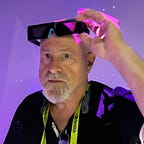VR Marketing at CES 2017
Intel, Samsung and Honda used VR to sell their ideas
One of the most remarkable things about CES this year was the number of companies using VR to tell their stories.
Intel CEO Brian Krzanich held his company’s CES press event inside virtual reality, providing 260 high-end Oculus VR units to those attending. They reportedly spent weeks running miles of wire through the event room to pull it off. Laura Anderson, a spokeswoman for Intel said, “This is the most technically difficult event we have ever done.” Barf bags were distributed, but not needed. Krzanich said that VR will likely change the way we work and play. He showed what’s it’s like to jump off a cliff, and demonstrated how a technician might use VR to inspect a solar array all powered, of course, by Intel’s technology.
Samsung claimed the mantle of 2016 mobile VR winner when it announced its GearVR has sold an impressive industry leading 5 million headsets. To celebrate, Samsung staged a flashy carnival attraction called “The Gear VR 4D Experience”, marrying their Gear VR headsets mounted with S7 smartphones with motion platforms to give users a theme park quality experience. By Saturday morning, the attraction was completely booked up for the weekend. Hundreds watched as those lucky enough to get a turn were bounced around, twisted and turned upside down to simulate skeleton sled racing, air acrobatics, a boat race and a spaceship racing experience. Monitors showed a high-definition version of what the riders were seeing, although inside the headset, users saw the classic VR “screen door” of the low resolution smart phone screen, in which visible pixels turn the most high definition images into soft focus. Many users looked green as they stumbled off the motion platforms. Still, no barf bags needed.
Honda used a custom VR installation in its booth, created with Dreamworks (using characters from their soon to be released “Trolls” animated movie) to take users on a virtual car ride through a 3D Las Vegas to show how digital technology in the car might someday interact with locations it approaches. The developers built in some mild gamification (click on Trolls to earn points) to make it more than a passive experience. Again, there was a long line waiting to strap on an Oculus headset to see what it was about.
Last, but hardly least, was Kino-mo, which was showing off its amazing Hypervsn retail promotion product, which uses a spinning LEDs to project animated, floating, holographic 3D images into space.
Their small booth in the crowded Sands Convention Center at the Venetian, about a mile from the LVCC, was absolutely mobbed. The UK based company was rapidly taking pre-orders from marketers who managed to push their way through the crush of curious onlookers to reps in the booth.
Also mention worthy was the highly visible American Greetings tent opposite central hall the LVCC. Seen by everyone, and visited by many curiosity seekers, AG sought to remind us of a simpler time, when a handwritten card was the way to reach someone, as opposed to a lazy like on Facebook or Twitter. AG artists added beautiful calligraphy to personalize cards for people who could then drop finished cards in snail mail right there in their tent. The whole thing struck me as an futile, expensive marketing gesture for a cute, sweet product slowly dying as digital generations succeed the old. It reminded me there is a cost to our progress, which is leading us into a cold, more fractured world, one where we are more likely to meet new people in a virtual world than the real one.
I don’t mean to come across as cynical and snarky. I genuinely like what AG did. I just doubt it accomplished anything other than evoking nostalgia for a simpler, nicer, high touch (not high tech) world.
Like this story? Get more in the weekly newsletter from CinematicVR.
